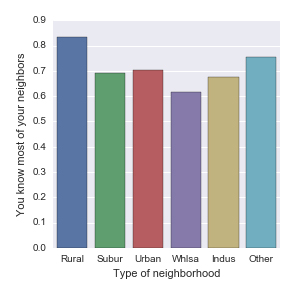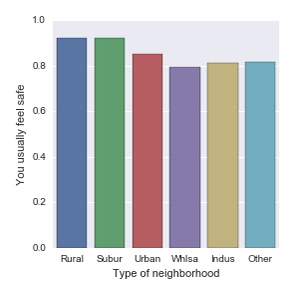Communities Data visualizations
by ptdriscoll
Comments Off on Rural teens know their neighbors more than teens in cities
Rural teens know their neighbors more than teens in cities
Where teens live makes a difference in how well they know their neighbors, shows an analysis of data from the National Longitudinal Study of Adolescent Health.
The data comes from a school-based survey of 6,504 youth in grades 7-12 in the U.S.
Nearly 4,700 adolescents living in either rural, suburban, urban or several other types of neighborhoods responded to: “You know most of the people in your neighborhood.”
Results show 83 percent of rural teens said yes, while 69 percent of suburban teens and 70 percent of urban teens said they do.

Rural vs. suburban and rural vs. urban are the only two comparisons within a standard 95 percent confidence level, analysis shows. None of the other neighborhood pairs meet the test, including the 1 percent gap between surburban and urban teens.
When it comes to safety, just 85 percent or urban teens said they usually feel safe in their neighborhood, while 92 percent of rural and suburban teens said they do. Those are the only comparisons with high enough confidence levels.

Adding a signal for outlook on life – grade point averages – sheds even more light. Here are some of the statistically significant relationships:
- Suburban teens have higher GPAs than urban teens, 2.9 compared to 2.8
- Teens who know most of their neighbors have, for some reason, slightly lower GPAs, 2.83 compared to 2.88
- Teens who usually feel safe have significantly higher GPAs, 2.9 compared to 2.6
So while research shows adults and communities benefit from social connections, when it comes to teens we shouldn’t overlook how safe they feel as a factor in success.
In another slice from the data, I looked at teens who drive and those who have driven before but don’t drive every week. Significant findings include:
- Teen who drive usually feel safer in their neighborhoods than those who don’t, 92 percent compared to 89 percent
- More rural teens drive, followed by suburban and then urban teens, 73 percent, 64 percent and 60 percent
- There’s no significant relationship between how often teens drive and how well they know or don’t know their neighbors
As noted in a previous blog post, a challenge with studies like this is how to define a neighborhood. Whether using physical boundaries, population densities, transportation options, etc., there’s no clear-cut answer. In this survey, the interviewers categorized respondents neighborhoods.
I used Anaconda Python packages to crunch the data and analyze relationships, and Seaborn to visualize the results.